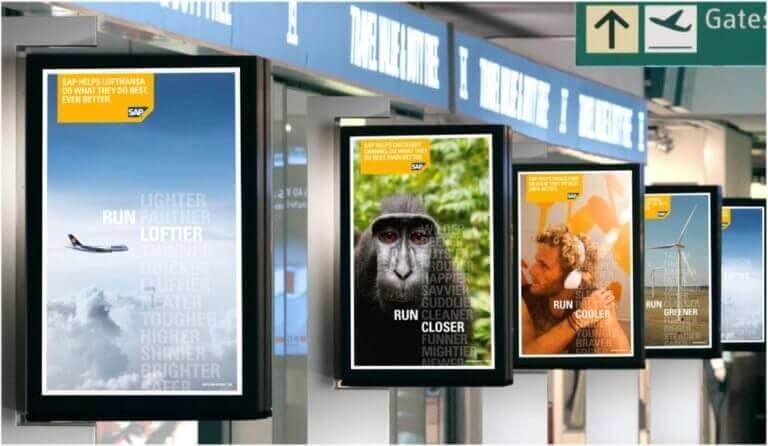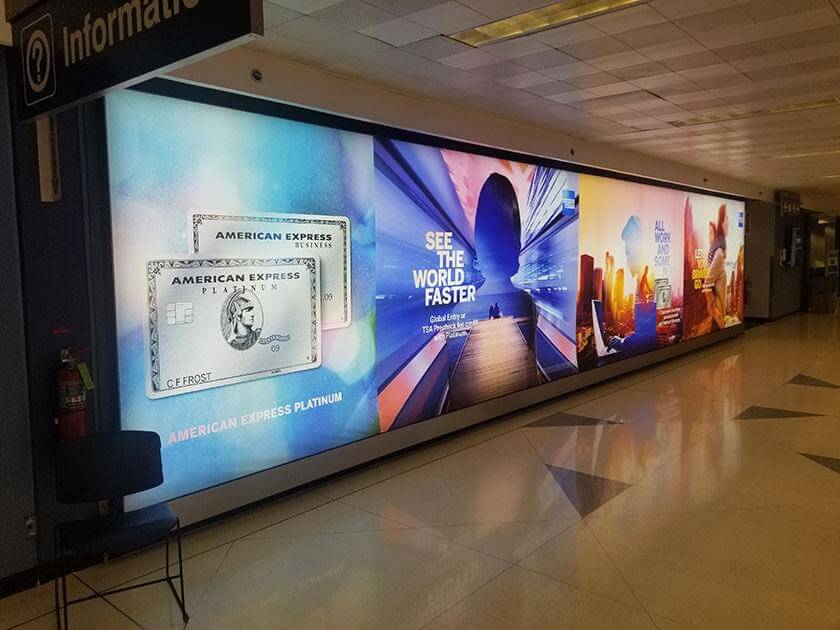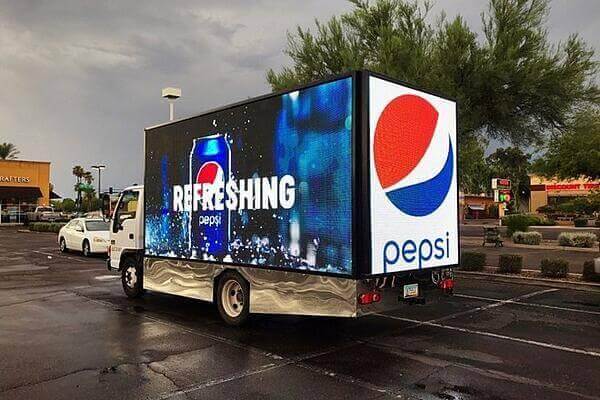
Airport advertising has been around for decades, as compared to the short-lived timeline of truckside advertising. However gaining popularity, truckside advertising is still a little-known medium that most people should be informed about. The impressions garnered from airport advertising can be matched with the impressions taken from a great truck advertisement. This article will look at the ways in which both advertising mediums work in this day and age, as well as compare and contrast the benefits of both services.
What is a Truckside Ad? What is an Airport Ad?
Before we name the pros and cons of both sides, there has to be a clear understanding of the two platforms and how they function. Truckside ads are advertisements on the sides and backs of trucks. They are clear to everyone that the truck passes because they leave a singular visual mark on the roads.
The concept of airport advertising isn’t as straightforward as truckside ads, since it’s a form of advertising that consists of multiple ad mediums. Airport advertising typically fits into billboards, in-flight magazines, banners, digital screens, and ad wrapped taxis. There is no limit to airport advertising since it can be presented in various ways. For example, The JCDecaux airport, an American airport, created a new ad space where companies put ads on security bin advertising. This new form of advertising guarantees that 100 percent of boarding passengers will see the ad. However, it can lead to a problem of security regarding bin advertising. Its design can be distracting to people, causing them to forget to take their loose change, for example. It goes to show that although airport advertising has its advantages, it also has some setbacks. Now, let’s draw some comparisons between the two.
From the Same Family Tree
While these forms of marketing can look like strangers to each other, in reality they are relatives from the same family tree. Although the two have their differences, truckside ads and airport ads are branches of OOH advertising. OOH stands for Out-Of-Home advertising and is often referred to as outdoor advertising. Truckside ads and airport ads are considered OOH advertising since they can be seen in a public settings instead of online and on TV. They take up public spaces without harming the design of the space.
The similarities don’t stop there. Airport ads and truckside ads are from the same category of OOH. These two advertising platforms belong to the category of billboard advertising. Billboard advertising is the most successful category of OOH. Compared to the other types, which include street furniture, transit advertising, and alternative OOH forms, it gets the most return on investment. About 65 percent of advertising revenue comes from billboards while the other categories bring in a tax of 16 percent or less. With the extra cash airport ads and truckside ads bring, they are indeed successful members of this OOH family.
Similar Targeted Audience
Between airport ads and truckside ads, the demographic audience may not always be the same, but that doesn’t mean there’s no similarity there either. Outside of the specific details like age, sex, and background, etc. there is a common trait between the targeted audience of airport ads and truckside ads: the two marketing strategies target people are on the move.
Whether it’s people traveling around the city or in more suburban areas, these ads are aware that people aren’t standstill and understand how to function in that environment. These two advertising powers attract a moving audience even though their sizes may vary.
Truckside ads work in a smaller audience scale since these ads capture the attention of drivers and sidewalk pedestrians. They are also better targeted to people who are on route to a destination that’s in driving distance. Airport ads, on the other hand, attract those who are traveling interstate or sometimes out of the country. Their moving audience is considered to be much larger. Remember, bigger doesn’t always mean better. Occasionally, it’s best to use truckside ads to lock in regular customers around the city while airport ads secure travelers and international consumers.
Both advertising methods are suitable in their own ways. Truckside ads are better for local businesses while airport ads are better for more established companies. The desire to connect to people traveling around is what makes airport ads and truckside ads similar, but also different because they accomplish different goals when attracting a certain audience type.
Using Technology to Turn More Heads
The traditional use of truckside billboards and airport ads are still relevant. Printed advertisements exist, but that doesn’t mean you can’t go digital. The innovative ways of technology manage to create a new vibe and leaves room for creativity to grow in these ads. The way airport ads and truckside ads use digital media are quite different from each other, but they are noteworthy and useful in terms of getting people’s attention from an alluring angle.
The Digital Growth of Airport Ads
Phones and other technologies need to be put on airplane mode during a flight, but that doesn’t mean that airplanes will forever ban active use of electronics in the future. TSA, an American travel organization, wants to make it possible for aviation security to evolve with technological growth. But, until we reach that point, airports will use technology to advance in a different field such as digital advertising.
In most airports, it’s pretty common to see digital ads. Digital billboards have a 55 percent recall rate, so it’s understood that they’re a valuable service. Digital billboards make it easier to catch a person’s attention and the modern aesthetic of these ads makes people inherently interested. Instead of looking tacky or mismatched, the natural incorporation of billboard advertising makes others want to look at the ad more. Moreover, its modern look can make a traveler’s first impression of a destination positive and can also make them more inclined in seeing the attractive ads displayed on screen. These electronic ads can be responsible for lifting up traveler’s moods and for decorating airports in visually stimulating ways.
The Digital Growth of Truckside Ads
In this industry, small details can go a long way. Some vehicles implement LED lights in their truckside ads. The lights are practical because they allow people to read the advertisement in the dark and it’s faster at catching people’s attention. This method is a cost-friendly way of incorporating electronics in advertising.
On the fancier side of things, some companies specialize in digital mobile billboards. Digital billboards can play videos on their surfaces. Some trucks display a picture on the road and loop a commercial when parked. Even without a video playing, a digital billboard is a dramatic twist in mobile ads and can be a star on its own.
Airport ads and mobile billboards grow differently in their own creative space but still amaze the audience with their technological progress. The way these advertising platforms incorporate technology creates a different vibe but manages to be an attention seeker to others around them. Their digital enhancements are used to turn more heads, but the execution remains memorable.
Some Major Differences Between Airport Ads and Truckside Marketing
Impression Count:
Airport Ads
It’s no surprise that airport ads draw in a higher impression count compared to truckside ads. On a daily basis, 2 million people use TSA airports. Although these are high numbers, take into account that most of these people are tourists coming in and out of the US. Having airport ads are great for big companies with international connections, but for smaller, within the city businesses, it’s best to use truckside advertisements.
Truckside Ads
Although the impression rate is lower, truckside ads still pack an impressive punch. In a 3M- sponsored study, it is estimated that the average truckside ad impression count consists of at least 40,000 impressions. Although the size is smaller, impression numbers build up over time. For example, a Travel Cuba campaign at Movia Media Truck Advertising got over 35 million impressions after its first two months. This campaign is one of many ad promotions that reached out to millions of people. The numbers do add up; you can expect a drive to arrive over a million impressions if you give it enough time.
Differences Between the Level of Interaction:
Airport Ads
There is more physical engagement in airport ads. Through the use of item bins, people are forced to look at the ad because they put their belongings in those bins before going through the x-ray — the way these ads are displayed guarantees that 100 percent of passengers see the advertisement.
Although people get to see the ad, it still gets covered by their personal belongings, so the effectiveness of the ad is questionable. By using security trays for advertising purposes, an ad has a one-second time frame to be looked at before it’s hidden with someone’s belongings. This method involves a lot of people looking at the ad but not enough time for them to read or retain the messaging.
Other than the security trays, US airports use other media forms to induce engagement. One advertising form is through the use of touch screens. With help from Posterscope USA, there are airport advertisement games.
These games are a subtle way of increasing brand awareness through a fun, interactive way meant for everyone. When people play these ad games they are positively engaged, as some people play multiple times. In order to increase the number of times a person plays, there are cash prizes that range from $250-500. These prizes motivate people to buy into the advertisement and the repetition is good for company recall.
Truckside Ads
How do truckside ads include interaction? In their case, there isn’t much interaction between the commercial and the person. These ads simulate the eye rather than a sense of touch. If there is interaction in truckside advertisements, it would be counter-intuitive. Truckside ads do best when they are on the road. If the truckside advertisement becomes playable, that will make the truck parked more often so people can engage with these features. Making truckside ads more interactive can amaze people, but it’s not the best way to reach a lot of them.
Expenses, How Much Budgeting Goes into These Ads?
Airport Ads
People can rent different types of ads at airports. When renting out an ad space, there is also a minimum number of ads a company must purchase before getting approved by the airport. The minimum number of ads can range between 5-20. Below is a chart of different ad formats and the expected price range.
| Format | Rate |
|---|---|
| Backlit Diorama (Gate/Terminal and Baggage Claim) |
Range of $3,500 – $9,900 per ad per 4 week period |
| Mini-Spectacular | Range of $5,500 – $12,900 per ad per 4 week period |
| Spectacular | Range of $11,500 – $19,900 airport ad per ad per 4 week period |
| Digital/LED/Video | Range of $3,500 – $9,500 per ad per 4 week period |
| Airport Banner | Range of $15,000 – $30,000 per ad per 4 week period |
| Airport Shuttle/Bus | Range of $4,000 – $8,000 per package of ads per 4 week period |
How expensive an airport ad can be depends on the size of the ad and how many impressions an ad is expected to get in that location. There is also the opportunity for non-profit organizations to receive advertising discounts.
Truckside Ads
For truckside ads, it costs more to get started than to continue advertising. There’s a truck ad design and production fee that is estimated to be around $3000-5000. This fee is usually a one-time thing unless you decide to change your ad design. To rent out the trucks, you can spend approximately $2000-3000 for four weeks. Unlike airport ads where the impression count is a fixed range, truckside ads have a growing impression count since they are not standstill. More money could be made doing truckside advertising since the initial investment rate is cheaper and they can reach more people compared to airport ads. Truckside advertising services may also be more flexible with campaign adjustments and flight timing schedules.
Can Truckside Ads Match Up to Airport Ads?
In short, they have the ability to. Truckside ads are impressive in how they grow digitally and rack up a high impression count. Airport ads have all those factors plus government funding to be even more significant. Overall, airport ads are in a different league compared to truckside ads. This loss doesn’t mean there is no victory later down the road — truckside ads have shown that they’re small but can reach a long way. As a growing industry, they can grow bigger and gain more momentum and representation like airport ads already have.
Keywords: TSA airport ads, Comparing truckside ads, Comparing TSA ads, TSA’s
Sources:
https://www.bluelinemedia.com/airport-advertising
https://www.fleetowner.com/mag/fleet_rolling_billboards
https://www.tsa.gov/blog/2018/01/29/tsa-year-review-record-amount-firearms-discovered-2017
http://www.jcdecauxna.com/airport/product/secure-tray-advertising
https://www.visix.com/resources/blog/40-digital-signage-statistics-that-prove-it-works/








